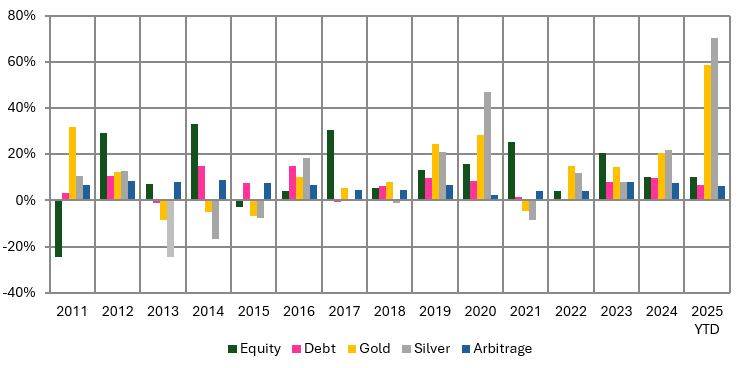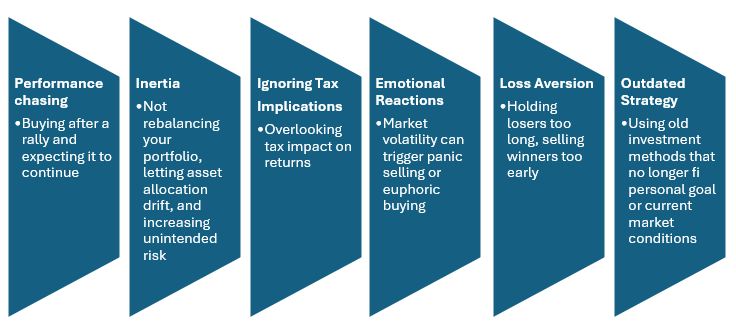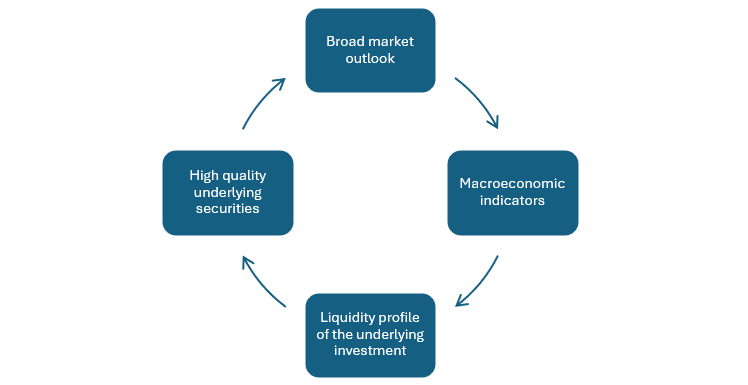PGIM India Multi Asset Allocation Fund NFO: Stability of multi asset allocation

PGIM India MF is launching a new fund offer (NFO), PGIM India Multi Asset Allocation Fund. As per SEBI’s mandate multi asset allocation funds must invest in three or more asset classes with minimum 10% exposure in each asset class. Multi asset allocation funds are increasingly becoming popular with retail investors. Between September 2020 to September 2025, assets under management (AUM) of multi asset allocation funds multiplied ~12X from Rs 12,073 crores to Rs 1.4 lakh crores (source: AMFI, 30th September 2025). PGIM India Multi Asset Allocation Fund opened for subscription on 11th November 2025 and will close on 25th November 2025. In this article we will review this NFO.
Importance of asset allocation
Asset allocation is one of the most important attribution factors of a portfolio’s performance. Different asset classes have different risk / return profiles and outperform / underperform in each other in different market phases. Asset allocation balances risk and return of your investment portfolio. Hybrid funds provide asset allocation solutions for investors of different risk profiles and investment goals.
Why multi-asset allocation funds?
- Diversifying beyond traditional asset allocation: Traditional asset allocation i.e., equity and debt can reduce portfolio risks, but over long investment tenures multi asset allocation (three or more asset classes) can harness the potential of other asset classes to enhance portfolio returns). For example, over the last 10 years, gold gave 16.5% CAGR returns (source: MCX, Advisorkhoj Research, as on 31st October 2025). Adding multiple asset classes to your investment portfolio will not just diversify risks, it will also has the potential of generating superior potential risk adjusted returns over long investment horizon.
- Winners rotate across asset classes: One asset class cannot outperform forever. Different asset classes emerge as winners in different years, depending on market and economic conditions (see the chart below).

Source: NSE, MCX, Advisorkhoj Research, as on 31st October 2025. Equity is represented by Nifty 50 TRI, Debt by Nifty 10 year Benchmark G-Sec Index, Gold and Silver by MCX spot prices and Arbitrage by Nifty Arbitrage Index.
- Equity and Gold are counter cyclical: The chart below shows the 1 year rolling returns of Nifty 50 TRI (representing equity) and gold over the last 20 years. You can see that gold outperformed in the periods where equity returns were low / negative. Multi asset allocation funds can protect downside risks due to gold allocation.

Source: NSE, MCX, Advisorkhoj Research, as on 31st October 2025
- Silver tends to outperform gold in bull market phases: The chart below shows the 1 year rolling returns of Nifty 50 TRI (representing equity), gold and silver over the last 10 years. You can see that silver outperformed in the certain market phases e.g., bull runs. Adding silver to your asset allocation will provide richer diversification. While both gold and silver are seen as safe haven assets, the industrial use of silver especially in new age technologies creates demand for the commodity in times of economic growth.

Source: NSE, MCX, Advisorkhoj Research, as on 31st October 2025. Equity is represented by Nifty 50 TRI, Gold and Silver by MCX spot prices
- Demand for silver is likely to rise in the future: Silver’s industrial use, especially in new age technologies like artificial intelligence infrastructure, quantum computing, and advanced battery systems, will increase the commodity’s demand in the future.
- Multi asset allocation funds can participate in growth upside while limiting downside risks: The chart below shows the 3 year rolling returns of simulated multi asset allocation fund portfolio (comprising of 30% Nifty 500 TRI, 35% Arbitrage, 15% Gold, 10% Silver and 10% CRISIL Short Term Bond Index). You can see that the simulated portfolio was able to limit downside risks. The average 3 year rolling returns of the portfolio was 11.5% versus 13.1% return of Nifty 500 TRI. In other words, multi asset allocation was able to generate superior risk adjusted return compared to pure equity.

Source: Bloomberg, PGIM India MF, as on 31st October 2025
- Avoid behavioural pitfalls

Asset allocation of PGIM India Multi Asset Allocation Fund
- Equity: 30-70% (including Derivatives)
- Precious Metals: 10-25% (Gold ETFs & Silver ETFs)
- Debt & Money Market: 10-35%
- REITs & InvITs: 0-10%
Asset allocation strategy
- Active multi asset allocation framework to capture upcycle during various market cycles with minimum 65% gross equity allocation to maintain equity taxation.
- 10-25% exposure to Gold ETFs & Silver ETFs to take advantage of diversification to provide a stable growth experience for the investor across tenor of investment
- Asset allocation will depend on:-

- High Quality and High Growth framework for stock selection.
Historical asset of simulated multi asset allocation portfolio

Source: Equity is represented by NIFTY 500 TRI, Arbitrage: NIFTY 50 Arbitrage Index; Debt: CRISIL Short Term Bond Index. INR values for Gold & Silver #-Simulated Multi Asset portfolio represents the back testing for the period mentioned. Simulated Multi Asset portfolio based on starting allocation of 30% Equity (Nifty 500 TRI), 35% Arbitrage, 15% Gold (INR), 10% Silver (INR), 10% Debt (CRISIL Short Term Bond Index) as on 31-Jan-2007. Rebalancing conducted on periodic intervals.
Equity strategy

Who should invest in PGIM India Multi Asset Allocation Fund NFO?
- Investors looking for capital appreciation and stability over long investment tenures
- Investors looking to diversify across multiple asset classes
- Investors with high risk appetites
- Investors with minimum 3 year investment horizon
Investors should consult their financial advisors or mutual fund distributors if PGIM India Multi Asset Allocation Fund is suitable for their investment needs.
Mutual Fund Investments are subject to market risk, read all scheme related documents carefully.
PGIM is the global investment management business of Prudential Financial, Inc. (PFI) USA, with USD 1.5 trillion1 in assets under management. We offer a broad range of investment capabilities through our multi-manager model along with experienced investment teams that assist you in achieving your financial goals. With a glorious legacy of 145 years, PGIM is built on the strength, stability and deep expertise in managing money. We offer you a long-term perspective, having weathered multiple market cycles, and see opportunity in periods of disruption.
Investor Centre
Follow PGIM India MF
More About PGIM India MF
POST A QUERY











